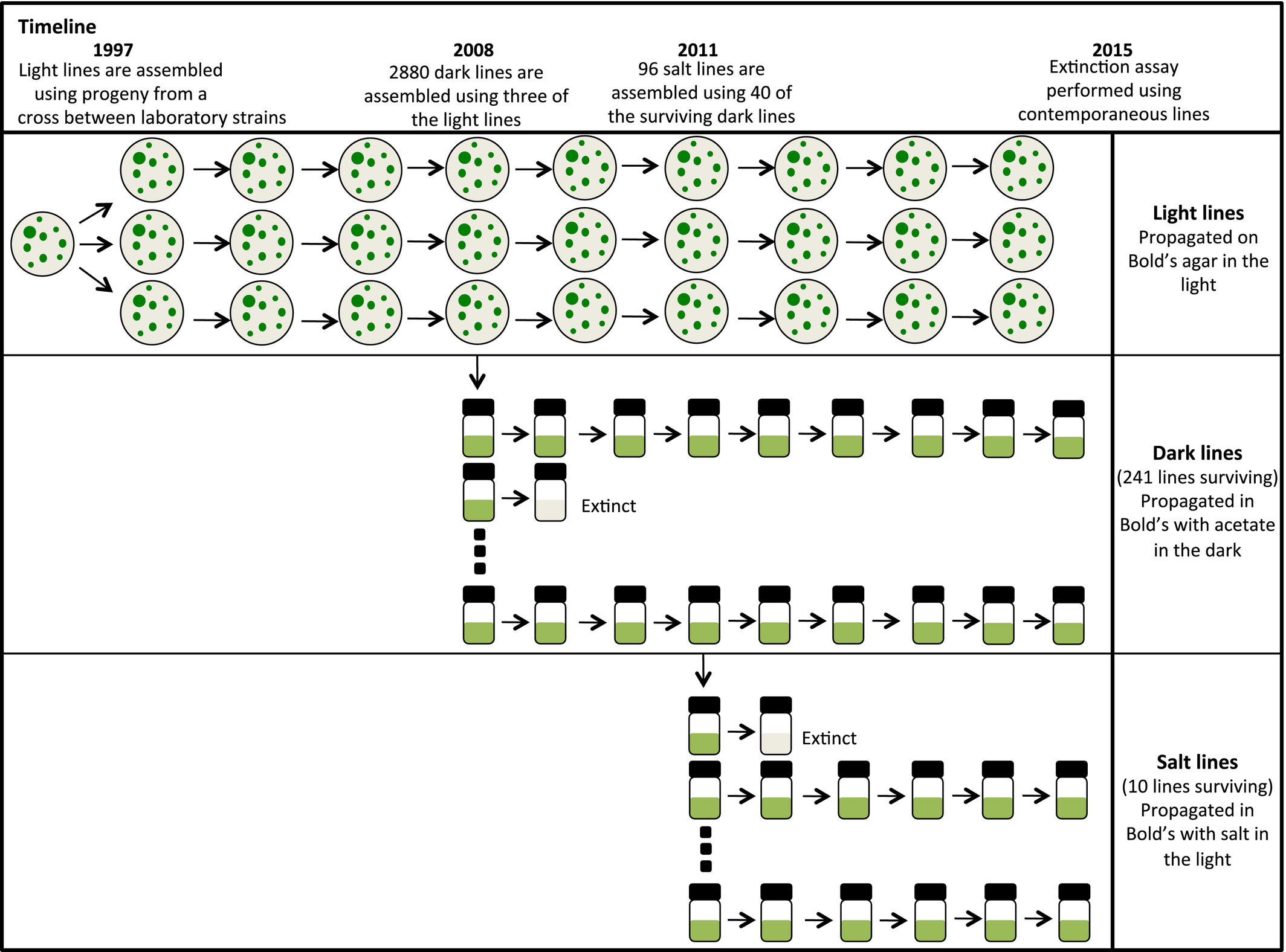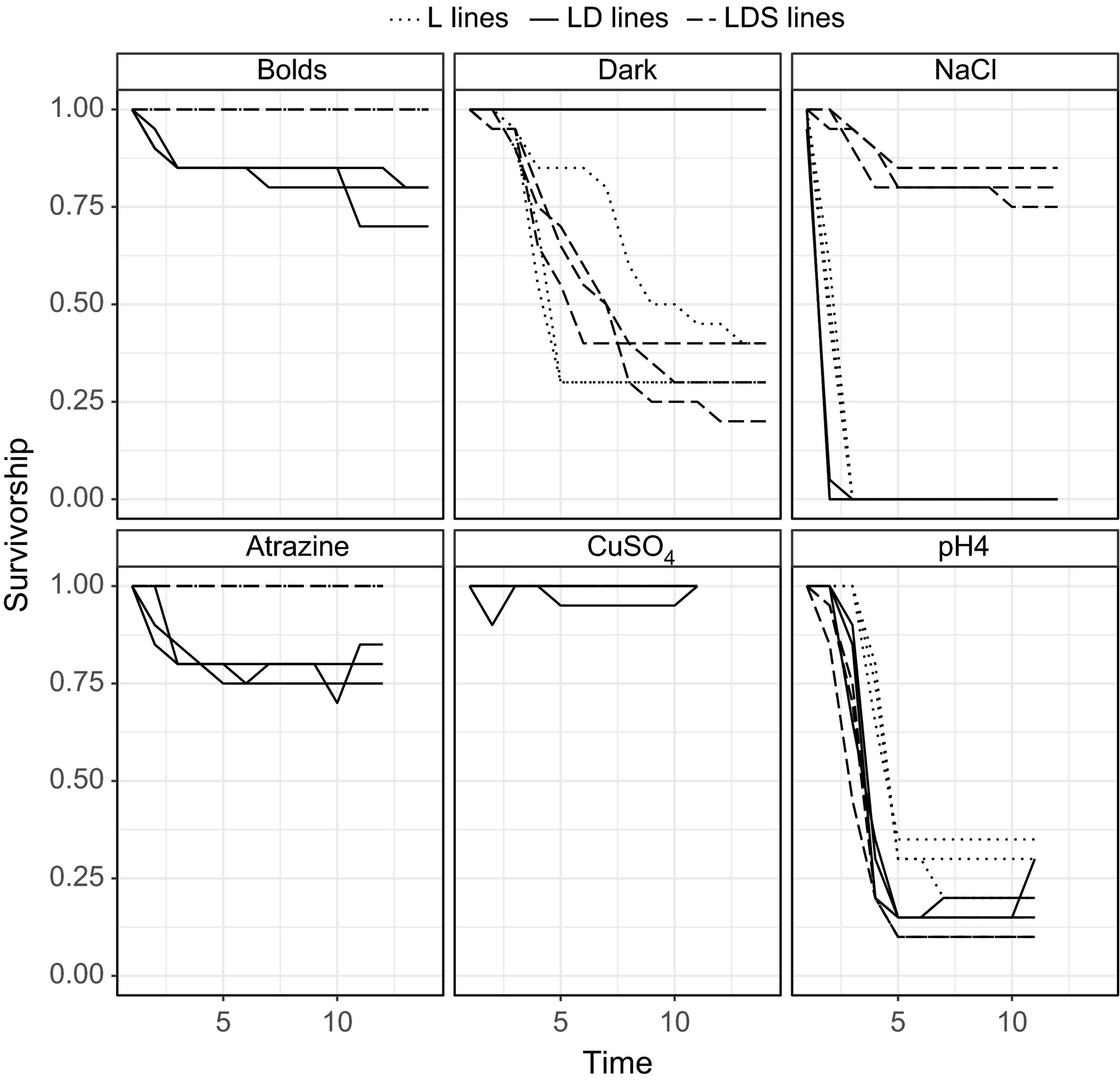Can Algae save the world?
In today’s world with an increasing human footprint across the natural world, scientists believe we may be entering a sixth mass extinction. Fragmented habitats, introduction of invasive species, and climate change are just some of the factors leading to this mass extinction. A lot of species still have yet to be recorded, so the number of extinctions of populations and species documented by scientists are likely to be large underestimates (Barnosky et al. 2011). Climate change is one factor among many that is leading to the loss of biodiversity. Therefore, it is important for scientists to understand how populations respond to rapid environmental change. It is known that evolutionary history may affect risk of extinction within populations due to the accumulation of mutations, or pleiotropy. In one environment certain mutations will be favored, but in others they may have detrimental effects that reduce fitness, or reproductive success of a certain genotype in a population. (genotype being the genetic makeup of an individual) This would lower a population’s ability to withstand environmental change due to the accumulation of mutations which aren’t suited for the new environment. (MacLean et al. 2004) Understanding evolutionary history is crucial for understanding how populations will respond to environmental change caused by climate change. In the October edition of the Journal of Evolutionary Biology there was a study looking at how evolutionary history affects extinction probability. Its title is “The effect of selection history on extinction risk during severe environmental change’. This study looked at how the extinction risk of populations of the green algae Chlamydomonas reinhardtii changed with various stressful environments (Lachapelle et al. 2017).
Well, they can at least provide us with some insight…
Because populations evolving in stressful environments, compared to populations evolving in benign environments may have a selection history that affects their extinction risks (Colegrave & Collins, 2008), the researchers of this study wanted to answer the question, “how does the history of natural selection affect the extinction rate?’ In order to answer this question, the researchers took a population of green algae that evolved in a benign environment, and compared it to populations which evolved in either one or two different stressful environments. The benign environment was just an environment with the light necessary for the algae to undergo photosynthesis. The stressful environments included a dark environment, and an environment filled with salt (NaCl).
How does the history of natural selection affect the extinction rate?
This study started back in 1997, in order to allow for adequate time for adaptation, when the first light lines (the benign environment) of C. reinhardtii were assembled. New lines of the algae were made from the original light lines by introducing descendants of the light line into the stressful environment of the dark environment (introduced in 2008). Then some of the descendants that were introduced to the dark environment were introduced into the salt environment (introduced in 2011).

In 2015, 18 years after the first lines of algae were started, extinction assays were made by the researchers for the three lines. An assay is a laboratory procedure which measures the amount of something being analyzed, which in this case is the percentage of algae which survive a change in their habitat. The abbreviations for these different lines are L, LD, and LDS. The L line is the light line or the population of algae brought up in the benign light environment. The LD line is the light dark line or the algae transferred from the light environment into the stressful dark environment. Lastly, the LDS line is the light dark salt line or the algae transferred from the light environment to the dark environment, and lastly to the salt environment. The extinction assays helped the researchers understand how past selection affected the probability of extinction in new stressful environments. To make this extinction assay, a spore from each line was grown from a single colony into a population in its home habitat (Light, dark, and NaCl). These populations were then transferred to assays of six different treatments. The first three treatments are just the aforementioned benign, dark, and salt environments. The last three represent new environments that are supposed to simulate rapid environmental change because all three of these novel environments negatively affect wild strains of algae. The first of these last three treatments was an atrazine (a type of herbicide) environment, and the last two of these three environments was a copper sulfate rich environment (CuSO4), and an acidic environment buffered to a pH of 4 using a phosphate solution. Using an inverted microscope, the researchers could determine if any living cells were left after the transfer to the six varying treatments, and if after two cycles of growth there were no living cells, the culture would be declared extinct.
I will survive said the algae
This experiment showed that the population with the lowest extinction rate was, interestingly enough, the ones that grew up in the benign light environment. On average and across all environments 24% of spores went extinct for the light line, 29% of spores went extinct for the LDS lines, and 39% of spores went extinct for the LD lines.

A few things to note: The Bolds environment in the figure is just the benign environment. At the bolds, atrazine, and CuSO4 environments, the survivorship is the same for both the L and LDS lines at one. (Notice the horizontal line across at one with no decrease in survivorship) This means that these environments did not negatively affect the populations of the L and LDS lines. At the CuSO4 environment, all of the different lines of algae had the same survivorship. If you take these few things into account, you can see that the light line has the highest survivorship (or the lowest chance of extinction). Despite the fact that L lines had the lowest chance of extinction, the L lines do not have a probability of going extinct that is statistically different from the LDS lines. Interestingly, the LDS lines go extinct at a much faster rate.
Another thing the researchers looked at was how past selection events, known as selection history, affected rate of extinction in the algae. In order for the researchers to understand how important this was for extinction, they looked at the repeatability of extinction. If the extinction rate was highly repeatable, then selection history played an important part in determining extinction probability, whereas low rates mean extinction was caused mostly by chance. If all populations from a particular line go extinct at a similar rate or all survive, then the extinction repeatability is high. The researchers found that the LDS and L lines had the lowest repeatability in extinction when compared to the LD lines. This is likely due to the fact that LDS and L lines have either a very high or very low rate of extinction caused by both of these lines being extremely sensitive to different environments. This means that the LDS and L lines have a high level of variance across the different environments. Despite LD lines having a higher level of extinction repeatability, genetic variance was higher in the LD lines. The cause of the high level of extinction repeatability is due to the fact that the LD lines had a poor survivorship when it comes to the wide range of novel environments.
Beating the Experiment Down (Oh, I meant to say breaking)
So what does this mean? Well this experiment found that for the different lines of this green algae, extinction risk was higher with the populations that had evolved in a stressful environment. Compare this to the strains of algae that had a history of selection in the benign, light environment which had lower extinction rates. This experiment also found that extinction rates were repeatable within the different histories of selection. This meant that the LDS, LD, and L lines showed repeatable extinction rates with each extinction assay. This may mean that if someone has information on the selection history of a population, they may be able to use it to predict the populations probability for going extinct when the environment changes.The researchers also found that there was no trend for extinction risk which increased or decreased due to the number of back to back stressful environments survived. They think that it may only be the latest stressful environment which determines the extinction risk in a new stressful environment. They state that the LDS line had the same rate of extinction in the dark environment as the L line despite the fact that the LDS line at one point in its evolutionary history evolved in the dark environment. This may suggest that the salt environment erased the effects of evolving in the dark environment, and that only the latest stressful environment survived determines probability of extinction in the next novel environment.
Three main takeaways from this experiment:
- The populations of algae which evolved in a stressful environment had a higher extinction risk.
- The selection history of a population may be used to predict the probability of going extinct.
- It may only be the latest stressful environment which determines extinction risk.
The Future
In today’s warming world it is important to understand how species respond to rapid, unpredictable environmental changes caused by climate change. This experiment took place in a lab controlled setting with microorganisms, but it would be interesting if similar findings were found within wild populations of algae, and in populations of larger organisms like mammals or birds. If understanding selection history can provide insight into how populations respond to future environmental change then it would be interesting to know if other studies have found similar results in organisms other than algae. If there has been no such studies it would be nice to know if this can be found in other species, both in populations studied in the lab and in the wild. Overall, this is an interesting idea that the history of selection can potentially be used to predict the rate at which a population goes extinct. This concept could be a useful tool in today’s rapidly changing world because scientists could use this to understand how populations will respond to rapid environmental change.
Further Readings
- What is Chlamydomonas reinhardtii?
- What do they look like and what do they do?
- This is a similar study but instead of algae this study is conducted with yeast.
- Another study looking at the history of selection.
- More algae dealing with changing environments.
References
- Barnosky, A. D., Matzke, N., Tomiya, S., Wogan, G. O., Swartz, B., Quental, T. B., . . . Ferrer, E. A. 2011. Has the Earth’s sixth mass extinction already arrived? Nature, 471: 51-57. doi:10.1038/nature09678
- Colegrave, N. & Collins, S. 2008. Experimental evolution: experimental evolution and evolvability. Heredity, 100: 464—470. doi: 10.1038/sj.hdy.6801095
- Lachapelle, J., Colegrave, N., & Bell, G. 2017. The effect of selection history on extinction risk during severe environmental change. Journal of Evolutionary Biology, 30: 1872-1883. doi:10.1111/jeb.13147
- MacLean, R.C., Bell, G. & Rainey, P.B. 2004. The evolution of a pleiotropic fitness tradeoff in Pseudomonas fluorescence. Proc. Natl. Acad. Sci. USA, 101: 8072—8077. doi: 10.1073/pnas.0307195101
